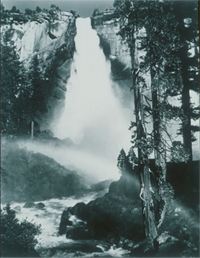| Through the generosity of Nancy and Russell Carlson, Everson Museum
has begun to strengthen and expand its collection of photography. Over the next several
years, the museum will be collecting American landscape photographs that will form what
will be known as the Nancy and Russell Carlson Collection. The first print to enter this
collection was recently purchased at auction. It is by Ansel Adams and is entitled Nevada
Fall, Rainbow, Yosemite Valley. |

Nevada Fall, Rainbow, Yosemite
Valley |
| The photographs of Ansel
Adams stand at a defining juncture in the story of America’s relationship with the
West and with nature. Adams (1902-1984) is heir to the American landscape tradition that
goes back to the 19th century and the grand surveys of the West that included
photographers Carleton Watkins, Timothy O’Sullivan, and William Jackson. Like his
forebears, Adams is best known for presenting the heroic grandeur of the Sierra Nevadas
and Yosemite Valley. Although notions of Manifest Destiny and the natural sublime were
part of history by the time Adams took up a camera, the need to celebrate and preserve
this unspoiled American landscape became more urgent during his lifetime. Adams’ body
of work—some 40,000 negatives and 10,000 signed prints—helped to establish
legislation that continues to protect the land he spent do much of his life photographing.
Ansel Adams is one of the best-known photographers
of the 20th century, but not only because of his photographs. He was also a
well-respected author, educator, lecturer, environmentalist, and pianist. As a founding
member of Group f/64, he helped to promulgate the aesthetic of "pure"
photography, a practice that advocated optically accurate prints, |
sharp focus, and great depth of
field—photographs that looked like photographs and not drawing or painting. Adams
believed in "visualization," the ability to reason out before the photograph
exposure how the final print would look. He felt that the careful choice of camera, lens,
filter, light, and angle were technical considerations that should be in service to the
expression of the photographer’s visual ideas.
"Ansel Adams is
one of the best known photographers of the 20th century"
As co-founder of Aperature magazine and an
organizing force behind the photography department at the Museum of Modern Art, Adams
ensured that photography received the critical attention it needed to be considered on an
equal footing with other arts.
In an Adams photograph, whether it is a sweeping
landscape of grandeur and majesty, a quiet cove, or a close up of some natural form, there
is typically a subject—a named mountain range, serpentine river, gnarled tree trunk,
impressive cloud formation, or frothy waterfall. |
In Adams’ photography we
are provided with a multitude of view points; we look up, down, or straight ahead at sky,
stony wall, or watery reflection. High horizons concentrate the vision, low horizons awe,
concealed horizons produce abstractions that highlight natural patterning. Light and dark
is a binary of the most importance in an Adams photograph, and the range of tonalities he
is able to capture produces much of the drama that is seemingly inherent in the landscape. In
the Everson’s photograph Nevada Fall, Yosemite Valley, a high horizon line
focuses attention on the framed fall of the Merced River, whose white pyramid vertically
cuts the picture plan in two. As it hits the plunge pool below the 594-foot-high
escarpment, the fall sends up a mist that generates a rainbow. Arching over the tumult of
the rocky cataract, the rainbow cuts across the bottom third of the composition. The
ephemeral, translucent nature of the rainbow contrasts with the ages-old character of the
mountainous cliff and the dense-white presence of the tumbling water. Two sequoia trees
that rise in the right foreground stand guard over the scene, help to frame it, and echo
the vertical plunge of the fall. The vista is at once picturesque, descriptive of
atmospheric and geological phenomena, and awe inspiring in the great physicality of the
various elements it depicts.
RETURN TO
ARTICLES PAGE |